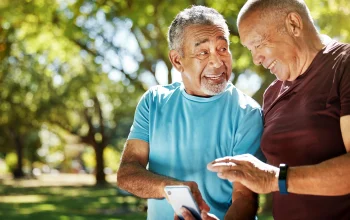Imagine your doctor, not in a white coat, but in your pocket. That’s the promise—honestly, it’s the reality—unfolding right now with digital therapeutics and mobile health apps. We’re not just talking about step counters anymore. This is a seismic shift in healthcare, moving from episodic clinic visits to continuous, personalized support that travels with you.
Let’s dive in. These tools are transforming remote patient monitoring from a clunky concept into a seamless part of daily life. They’re giving patients real agency and giving clinicians a window into what happens between appointments. It’s a whole new world.
So, What Exactly Are We Talking About? DTx vs. mHealth
First, a quick distinction. It’s easy to lump everything together, but there’s a crucial difference.
Mobile Health (mHealth) Applications
Think of these as the broad toolkit. mHealth apps are the wellness trackers, medication reminders, and symptom loggers. They’re about management and awareness. They collect data—your heart rate, your mood, your blood sugar—and present it to you. They’re incredibly valuable, sure, but they’re often general-purpose.
Digital Therapeutics (DTx)
Now, DTx is where it gets serious. These are evidence-based, clinically evaluated interventions used to prevent, manage, or treat a medical disorder. They’re not just tracking your diabetes; they’re delivering a structured, personalized program to help you manage it, often with the same rigor as a prescribed drug. In fact, they are often prescribed by a doctor.
So, while an mHealth app might remind you to breathe, a DTx program for anxiety actively guides you through cognitive behavioral therapy exercises proven to rewire your response to stress. It’s the difference between a tool and a treatment.
The Engine of Change: Remote Patient Monitoring
This is the connective tissue. Remote patient monitoring, or RPM, is the process that brings it all to life. It uses digital technologies to collect medical and other health data from you—from the comfort of your home—and securely transmits it to your care team.
Here’s the deal: RPM closes the feedback loop. It turns passive data into active insights.
| Traditional Care | RPM-Enhanced Care |
| Snapshot-in-time checkups | Continuous, real-time data stream |
| “How have you been feeling?” (Relies on memory) | “Your blood pressure spiked Tuesday night. What happened?” (Data-driven) |
| Reactive treatment | Proactive, early intervention |
For a patient with congestive heart failure, an RPM system can alert a nurse that the patient’s weight is creeping up—a key sign of fluid retention—days before they’d feel sick enough to call the doctor. That’s powerful. That’s preventative.
Where This Is Actually Working: Real-World Applications
This isn’t just theoretical. These technologies are already making a tangible difference in some of the most challenging chronic conditions.
Chronic Disease Management
Diabetes is the classic example. Smart glucose meters sync directly with apps, which then provide personalized coaching on insulin dosing, diet, and exercise. Some systems can even predict hypoglycemic events, giving the user a crucial heads-up. It’s like having a diabetes educator on call 24/7.
Mental and Behavioral Health
This is a massive area for DTx. Apps for conditions like PTSD, substance use disorder, and insomnia deliver structured therapeutic programs. They use lessons, interactive exercises, and mood tracking to build coping skills. For someone who can’t access a therapist weekly, this provides a consistent, accessible support system.
Post-Operative and Rehabilitation Care
After knee surgery, patients can use an app with their phone’s camera to guide them through physical therapy exercises. The app can even measure their range of motion to ensure they’re doing them correctly. This not only improves outcomes but also frees up clinicians to focus on the most complex cases.
The Flip Side: Challenges on the Road to Adoption
It’s not all smooth sailing, of course. Widespread adoption faces some real hurdles.
First, the “digital divide.” Not everyone has a smartphone, reliable internet, or the digital literacy to use these tools effectively. We risk leaving vulnerable populations behind if we’re not careful.
Then there’s data privacy and security. You’re sharing incredibly sensitive health information. Who has access to it? How is it being used? Robust regulations and transparent policies are non-negotiable.
And let’s talk about integration. For a busy primary care physician, another data stream can feel like a flood. These tools need to integrate seamlessly into existing Electronic Health Record (EHR) systems. If it creates more work, it won’t stick.
Finally, proving long-term efficacy and getting insurers on board with reimbursement is a slow, complex dance. The evidence is growing, but the system is, well, the system. It moves slowly.
The Future is Integrated, Not Isolated
So where is all this heading? The future isn’t a thousand disparate apps. It’s a unified, connected ecosystem.
Think about it: your smartwatch detects an irregular heart rhythm. It prompts you to take a single-lead EKG with an attachment. That data is automatically sent to your DTx platform, which analyzes it and, if concerning, creates an alert for your cardiologist—all before you even feel a symptom.
This is the move from reactive sick-care to proactive, truly continuous health-care. It’s about creating a partnership between you, your data, and your care team. The technology becomes a quiet, intelligent background layer to your life, not another chore.
That said, the human element remains irreplaceable. The goal of these tools is to augment clinicians, not replace them. To free them from administrative tasks and data-sifting, so they can focus on what they do best: complex decision-making and providing human compassion and connection.
The clinic of the future might not have more walls. It might just have better connections.





